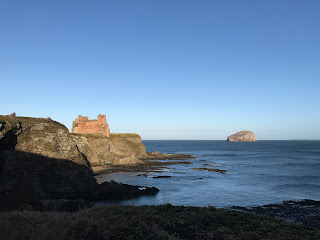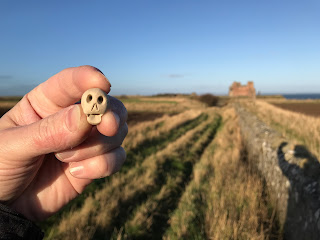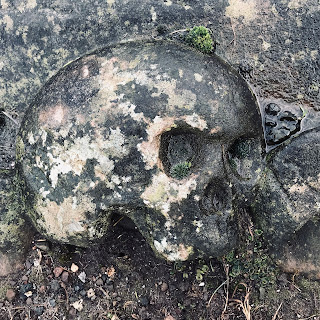I
know, from the photographs it looks like nothing more than a grass covered hill
and some rocks, but back in the 15th Century there was a small
village nestling here. A survey of the
area in 1962 found some remnants of the village, a few traces of walls and the outlines
of a building, but nothing much else. When the village was abandoned, and why,
no-one knows. Maybe the inhabitants were wiped out in one of the plagues that
swept through the country several hundred years ago, or maybe the village just
died a natural death. People moved out
and away, the last of the old inhabitants died and the few remaining houses
were abandoned to time and the elements.
The
village was once home to the philosopher, theologian, historian and scholar,
John Major (also known as John Mair or John Mayr), 1469 – 1550. He was born in
the village and spent his childhood and early youth there.
Major
left the village, and Scotland, during the 1490s to study at Cambridge and then
Paris. He later taught at both the Sorbonne and Montaigu College. While in
Paris he wrote Historia Majoris Brittaniae, a history of both England
and Scotland, which unlike previous histories written about Scotland, cut out
much of the myth and magic, and saw the country as being an integral part of
Britain. In 1518 he returned to Scotland as Professor of Philosophy and
Divinity at Glasgow University. There his pupils included both John Knox
(theologian, preacher, and misogynist nutter) and Patrick Hamilton (Protestant
reformer burnt at the stake in 1521 for heresy). In 1522, Major moved to the
University of St. Andrews, and taught there for a while before briefly
returning to Paris. He then returned once more to Scotland and St Andrews,
where he was made Provost of St Salvator's College. He remained there until his
death in 1550.
Now
largely forgotten, much like his namesake, you know the one – the Grey Man of
politics, Major was seen as an important figure during his lifetime and beyond.
Some of his teachings seem quite enlightened for the time, in that after the
Spanish ‘discovery’ of America, Major argued that the native peoples there had
political and property rights and that at the very least they should be
compensated for any land taken from them.
Despite
having travelled and lived in some of the fabulous cities of that age, Major
never forgot his roots and he styled himself as ‘Glegornesis’ in the titles of
several of his works. He was also known to often reminisce about the oatcakes
his mother cooked on the gridle over the ashes in the fireplace hearth, of
catching lobster and crabs at North Berwick, and of how the Solent Geese nested
on the Bass Rock each year.
I
walked out from North Berwick to Halflandbarns, and then down a dirt farm track
to Gleghornie farm. Just past the farm I made my way down another dirt track which
led me out to the open and rocky area where the village once stood. There, in a
gap in the old stone wall running around the boundary of the land, I left the
Skulferatu that had accompanied me on my walk.
The
coordinates for the location of the Skulferatu are –
Latitude
56.036317
Longitude
-2.654008
what3words:
bandstand.passwords.prowess
I
used the following sources for information on Gleghornie and John Major –
Canmore - Gleghornie
Pre-reformation Scholars in Scotland in the
XVIth Century
by William Forbes-Leith
1915
The Catholic Encyclopedia
Catholic Encyclopedia: John Mayor
John Major of Haddington
E. J. G. Mackay
1892











.jpg)
.JPG)
.JPG)
%20-%20Seacliff%20Cave%20from%20%20Notes%20on%20an%20Ancient%20Cave,%20&c.,%20discovered%20at%20Aldham,%20now%20called%20Seacliff,%20in%20East%20Lothian,%20in%201831%20by%20George%20Sligo,%20Vol%204%201857%20Archaeologia%20Scotica.jpg)
.JPG)
.JPG)
.jpg)
.JPG)
.JPG)
.jpg)
































